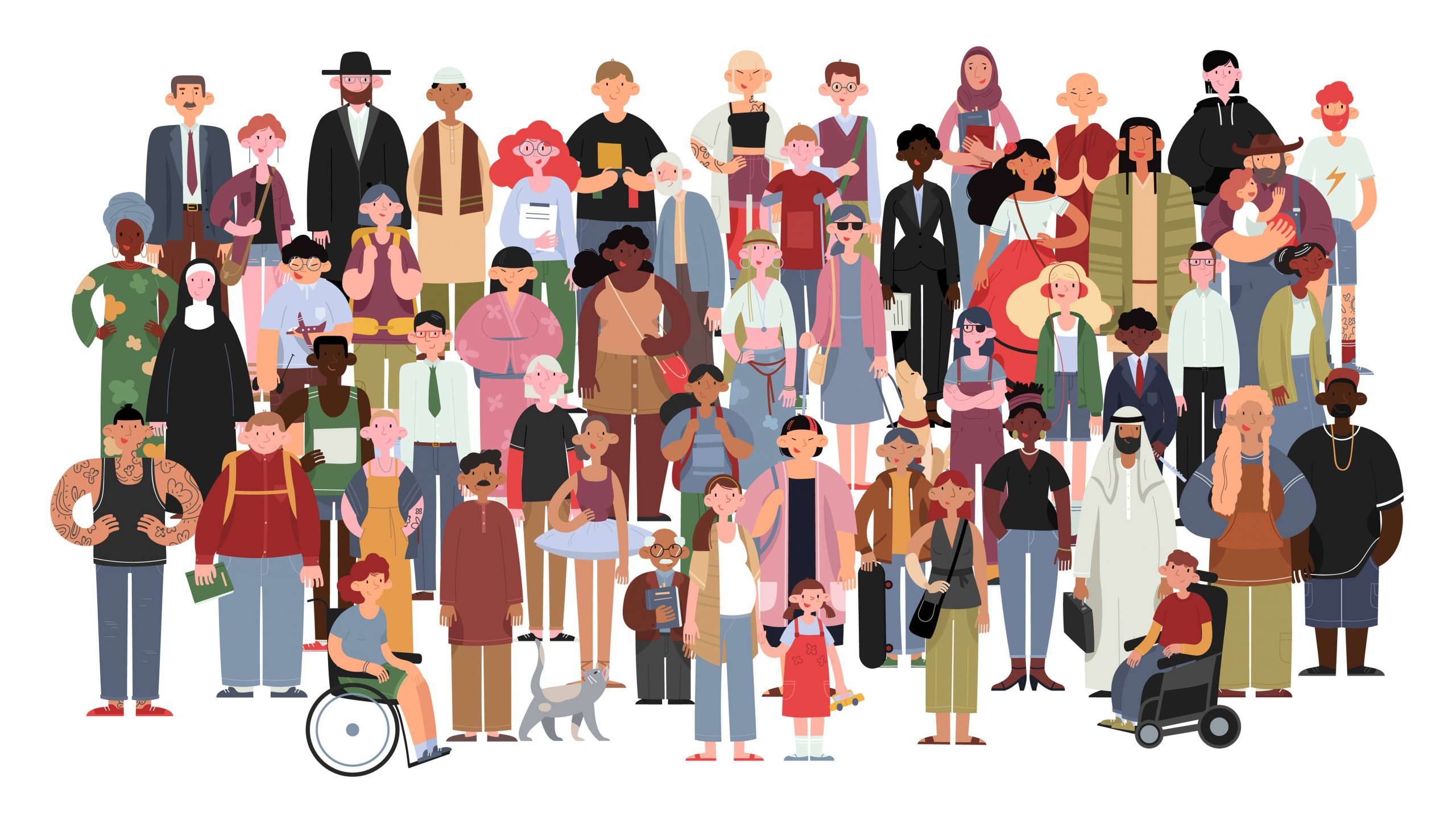Becoming an effective multicultural Counsellor
Understanding & Addressing Diversity

Part of the process of becoming an effective counselor involves learning how to recognize diversity issues and shaping your counseling practice to fit the clients worldview. It is an ethical obligation for counselors to develop sensitivity to cultural differences if they hope to make interventions that are consistent with the values of their clients. The therapist’s role is to assist clients in making decisions that are congruent with the clients’ worldview, not to convince clients to live by the therapist’s values.
Diversity in the therapeutic relationship is a two-way street. Counselors bring their own heritage with them to their work, so you need to recognize the ways in which cultural conditioning has influenced the directions you take with your clients. Unless the social and cultural context of clients is taken into consideration, it is most difficult to appreciate the nature of their struggles. Indeed, some clients have a difficult time in seeking and accepting professional help. Counseling students often value characteristics such as making their own choices, expressing what they are feeling, being open and solve, revealing and striving for independence. Just some clients may not share these goals. Clients may be very slow to disclose and have different expectations about counseling than the therapist has. It is essential that counselors become aware of how clients from diverse cultures may perceive them as therapists, as well as how clients may perceive their value of formal helping. It is the task of counselors to determine whether the assumptions they have made about the nature and functioning of therapy are appropriate for culturally diverse populations.

Clearly, effective counseling must take into account the impact of culture. Culture, is quite simply, the value and behavior shared by a group of individuals. It is important to realize that cultures refer to more than ethnic or racial heritage; culture also includes factors such as age, gender, religion, sexual orientation, physical and mental ability, and socioeconomic status.
ACQUIRING COMPETENCIES IN MULTICULTURAL COUNSELLING
Effective counselors understand their own cultural conditioning, the condition of their clients, and the socio-political system of which they are a part. Acquiring this understanding begins with counselors’ awareness of any cultural values, biases and attitudes they may hold. A big part of becoming a diversity-competent counselor involves challenges, the values we hold and how such values are likely to influence or practice with diverse clients. Furthermore, becoming an diversity competent practitioner is not something that we arrive at once and for all; rather, it is an ongoing process.
Sue, Arredondo, and McDavis (1992) and Arredondo and her colleagues (1996) have developed a conceptual framework for competencies and standards in multicultural counseling. Their dimensions of competency involve three areas. (1) Beliefs and attitudes, (2) knowledge, and (3) skill. For a more in depth treatment of multicultural counseling and therapy competencies, refer to D.W. Sue and Sue’s (2003) excellent book Counseling the Culturally Diverse Theory and Practice.
Beliefs and attitudesFirst, effective counselors have moved from being culturally unaware to ensuring that their personal biases, values, or problems will not interfere with their ability to work with clients who are culturally different from them. They believe cultural self-awareness and sensitivity to one’s own cultural heritage are essential for any form of helping. Counselors are aware of their positive and negative emotional reactions toward other racial and ethnic groups that may prove detrimental to establishing collaborative helping relationships. They seek to examine and understand the world from the vantage point of their clients. They respect the clients’ religious and spiritual beliefs and values. They are comfortable with differences between themselves and others in terms of race, ethnicity, culture and beliefs. Rather than maintaining that their cultural heritage is superior, they are able to accept and value cultural diversity. They realize that traditional theories and techniques may not be appropriate for all clients or all problems. Culturally skill counselors monitor their functioning through consultation, supervision and further training or education.
Previous slide
Next slide
KnowledgeSecond, culturally effective practitioners possess certain knowledge. They know specifically about their own racial and cultural heritage and how it affects them personally and professionally. Because they understand the dynamics of oppression, racism, discrimination and stereotyping, they are in a position to detect their own racist attitudes, beliefs and feelings. They understand the worldview of their clients and they learn about their clients’ cultural backgrounds. They do not impose their values and expectations on their clients from differing cultural backgrounds and avoid stereotyping clients.Culturally skilled counselors understand that external sociopolitical forces influence all groups, and they know how these forces operate with respect to the treatment of minorities. These practitioners are aware of the institutional barriers that prevent minorities from utilizing the mental health services available in their communities. They possess knowledge about the historical background, traditions and values of the clients populations with whom they work. They know about minority family structures, hierarchies, values and beliefs. Furthermore, they are knowledgeable about community characteristics and resources. Culturally skilled counselors know how to help clients make use of Indigenous support systems. In areas where they are lacking in knowledge, they seek resources to assist them. The greater their depth and breadth of knowledge of culturally diverse groups, the more likely they are to be effective practitioners.
Previous slide
Next slide
Skills and Intervetion StrategiesThird, effective counselors have acquired certain skills in working with culturally diverse populations. Counselors take responsibility for educating their clients to the way the therapeutic process works, including matters such as goals, expectations, legal rights and counselors’ orientation. Multicultural counseling is enhanced when practitioners use methods and strategies and define goals consistent with the life experience and cultural values of their clients. Such practitioners modify and adapt their interventions to accommodate cultural differences. They do not force their clients to fit within one counseling approach, but they recognize the counseling techniques may be culture-bound. They are able to send and receive both verbal and nonverbal messages accurately and appropriately. They become actively involved with minority individuals outside the office (Community events, celebrations, and neighborhood groups). They are willing to seek out educational, consultative and training experiences to enhance their ability to work with culturally diverse client populations. They consult regularly with other multiculturally sensitive professionals regarding issues of culture to determine whether or where referral may be necessary.
Previous slide
Next slide
Incorporating Culture Into Counselling Practice
Although increased attention is being given to coursework in multicultural issues, many practitioners remain uncertain about how and when to incorporate multicultural awareness and skills in their clinical practice (Cardemil & Battle, 2003). One way to actively incorporate multicultural dimensions is to initiate open discussions with clients regarding issues to raise and ethnicity. Cardemil and battle contend that doing so enhances the therapeutic alliance and promotes better treatment outcomes. To provoke thought and stimulate conversations about race and ethnicity, they suggest that therapists incorporate these recommendations throughout the therapeutic process:
- Suspend preconceptions about clients, race/ethnicity and that of their family members. Avoid making incorrect assumptions that could impede the development of the therapeutic relationship. Ask clients early in the therapist process how they identify their race/ethnicity.
- Engage clients in conversations about race and ethnicity to avoid stereotyping and making faulty assumptions. Clients may be quite different from other members of their racial/ethnic group.
- Address how racial/ethnic differences between therapist and client might affect the therapy process. Although it is not possible to identify every between-group difference that could surface during the course of therapy, therapists need to be willing to consider the relevance of racial/ethnic differences with clients.
- Acknowledge that power, privilege and racism can affect interactions with clients. Having discussions in these areas is invaluable in strengthening the therapeutic relationship.
- Recognize that the more comfortable therapists are with conversations about race and ethnicity, the more easily they can respond appropriately to clients who may be uncomfortable with such discussions.
- Be open to ongoing learning about cultural factors and how they may affect therapeutic work. Be willing to identify an examine your own personal worldview, assumptions, and personal prejudices about other racial/ethnic groups. Realize that the skill does not develop quickly or without effort.
It is unrealistic to expect a counselor to know everything about the cultural background of a client, but some understanding of the client’s cultural and ethnic background is essential. There is much to be said for letting clients teach counselors about relevant aspects of their culture. It is a good idea for counselors to ask clients to provide them with information they will need to work effectively. Incorporating culture into the therapeutic process is not limited to working with clients from a certain ethnic or cultural background. Instead, it is critical that therapies take into account the worldview and background of every client. Failing to do this seriously restricts the potential impact of the therapeutic endeavour.
In the case of individuals who have the experience of living in more than one culture, it can be very useful assess the degree of acculturation and identity development that has taken place. Clients often have alliances to their culture of origin, and yet they may find certain characteristics of their new culture attractive. They may experience conflicts in integrating the two cultures in which they live. These core struggles can be explored productively in the therapeutic context if the counselor understands and respects this cultural conflict.

Welcome DiversityCounseling is, by its very nature diverse in a multicultural society, so it is easy to see that there are no ideal therapeutic approaches. Different theories have distinct features that have appeal for different cultural groups. Some theoretical approaches have major limitations when applied to certain populations. Effective multicultural practice demands an open stance on the part of the practitioner, flexibility and a willingness to modify strategies to fit the needs and the situation of the individual client. Practitioners who truly respect their clients will be aware of the clients’ hesitations and will not be too quick to misinterpret this behavior. Instead, they will patiently attempt to enter the world of their clients as much as they can. It is not necessary for practitioners to have the same experiences as our clients, but they should be open to a similar set of feelings and struggles. It is more often by differences than by similarities that we are challenged to look at what we are doing.
Previous slide
Next slide
Multicultural GuidelinesWestern society is becoming increasingly diverse, yet our therapy models are based primarily on Eurocentric assumptions, which do not always consider the influence and impact of racial and cultural socialization. To address the knowledge and skills needed in our changing world, the APA provides professionals with a framework for delivering services to our diverse population. Although these guidelines have been developed specifically to aid psychologists, other practitioners may also find them useful. 1. “Psychologists are encouraged to recognize that, as cultural beings, they may hold attitudes and believes that can detrimentally influence their perceptions of and interactions with individuals who are ethnically and racially different from themselves.” (p.382) 2. “Psychologists are encouraged to recognize importance of multicultural sensitivity/responsiveness to, knowledge of, and understanding about ethnically and racially different individuals.” (p. 385) 3. “As educators, psychologists are encouraged to employ the constructs of multiculturalism and diversity in psychological education.” (p. 386) 4. “Culturally sensitive psychological researchers are encouraged to recognize the importance of conducting culture-centered and ethical psychological research among persons from ethnic, linguistic, and racial minority backgrounds.” (p.388) 5. “Psychologists are encouraged to apply culturally appropriate skills in clinical and other applied psychological practices.” (p.390) 6. “Psychologists are encouraged to use organizational change processes to support culturally informed organizational (policy) development and practices.” (p. 392)
Previous slide
Next slide
It takes time, study and experience to become an effective multicultural counselor. Multicultural competence cannot be reduced simply to cultural awareness and sensitivity, to a body of knowledge, or to a specific set of skills. Instead, it requires a combination of all these factors.
UNDERSTANDING AND ADDRESSING DIVERSITY
There are many types of diversity to consider, but perhaps the ones that come to mind most readily revolve around raising ethnicity. I would like to broaden the discussion to include spiritual as well as cultural factors. As you read, think about how open you are to learning about diversity as it pertains to your consuming practice.
Multicultural Concerns
Multiculturalism cannot be ignored by practitioners if they hope to meet the needs of their increasingly diverse client groups. Traditional theories of counseling have been criticized by some practitioners for having major limitations with respect to working with culturally diverse clients (Sue & Sue, 2008). I believe that contemporary theories can be expanded to incorporate a multicultural component. Many of the key concepts of these theories can be adapted to a cultural framework that has meaning for diverse client groups (Ivey, D’Andrea, Ivey & Simek-Morgan, 2007). Multicultural theory is grounded on the premise that assessment and treatment must take into account the cultural experiences and contexts that shape clients’ identities. Multicultural counseling and therapy embrace techniques drawn from various therapeutic approaches, but adapt these methods to the cultural values and expectations of individual clients. (Ivey & Brooks-Harris, 2005).


In writing about integrative psychotherapy with culturally diverse clients, Ivey and Brooks-Harris (2005) contend that all therapy is multicultural in nature, in that it is necessary to pay attention to many contextual and socialcultural factors. They argued that the notion of “one best theory” will eventually be a thing of the past as new ways of integrating theory and practice evolve. They write: “Bringing into the therapeutic hour dimensions of race/ethnicity, gender, sexual orientation and disability enriches in individual uniqueness. Discarding the outmoded concept of self and replacing it with self-in-context, being-in-relation, and person-in-community will enable us to think of what it is to be human in new ways. Multicultural therapy is leading us in a new direction” (p.335).
CAUTION: Individuals within a particular group may differ more than individuals from various groups. I like the perspective taken by Vontress, Johnson and Epp (1999), who advocate a conceptual approach to counseling in which the focus is always on the individual rather than on the individual’s race, ethnicity, or cultural background. Despite cultural differences, they maintain that it is important to recognize that people are more alike than different. They remind us that clients at times seek counseling over problems in living that do not pertain primarily to their race, ethnicity, or cultural origin.
Vontress and his colleagues place emphasis on basic human conditions that transcended culture, such as existential concerns about living, loving and dying. Being existential oriented, these writers state that a human-to-human encounter is therapeutic for all clients, regardless of their cultural background. How this encounter occurs, however, is culturally determined. Keep in mind that different cultures ascribe varying meanings and definitions to the universal existential concerns. Although mental health problems are best understood in a cultural context, it is essential to remember that each client is a unique individual. The central challenge we face working with clients who differ from us is to find a way to pay attention to what is significant to them and to get into their world. We can accomplish this goal by listening to what our clients are expressing and respecting what we hear.

Diversity As Central In The Counseling Process
According to Paul Pedersen (1997, 2008), the multicultural perspective seeks to provide a conceptual framework that both recognizes the complex diversity of a pluralistic society and suggests bridges of shared concern that link all people, regardless of their differences. This perspective looks at both the unique dimensions of a person and how this person shares themes with those who are different. Mere knowledge of certain cultural groups is not enough; it is important to understand the variability within groups. Each individual must be seen against the backdrop of his or her cultural group, the degree to which he or she has become acculturated, and the level of development of racial identity.
Pedersen (1997, 2000, 2008) emphasizes the importance of understanding both group and individual differences in making accurate interpretations of behavior. Pedersen (2008) contends that it is no longer possible for therapists to ignore their own cultural context or the cultural context of their clients. Whether practitioners pay attention to cultural variables or ignore them, culture will continue to influence both the client’s and the therapist’s behavior and the counseling process as well. Counselors who ignore culture will provide less effective services. Understanding the role that diversity plays in the therapeutic process is essential to successful outcomes.
Pedersen (cited in Nystul, 1999; Pedersen 2008) has moved toward a culture-centered approach to counseling, maintaining that accurate assessment, meaningful understanding and effective intervention demand that the client’s cultural context be central to the counseling process. Pedersen (2008) believes culture-centered interventions depend on an inclusive definition of culture as well as a broad definition of the counseling process. Pedersen defines culture broadly to include variables such as race/ethnicity, gender, age, socioeconomic status, religion, sexual orientation and disability. Using this framework, all counseling can be considered multicultural. He contends that by defining culture broadly, it is possible to view culture as the “thousand persons” we all have collected from various sources, who follow us wherever we go and who influence all our decisions. For us to have a sense of cultural self-awareness, it is necessary for us to have access to and dialogue with those inner voices.

Technical eclecticism seems especially necessary in working with a diverse range of cultural backgrounds. Harm can come to clients who are expected to fit all the specifications of a given theory, whether or not the values espoused by the theory are consistent with their own cultural values. Rather than stretching your client to feed the dimensions of a single theory, you must make your theory and practice fit the unique needs of the client. This requirement calls for you to possess knowledge of various cultures, awareness of your own cultural heritage and skills to assist diverse clients in meeting their needs within the realities of their culture.
Counselors must be able to assess the special needs of clients. Depending on the individual client’s ethnicity and culture, and also on the concerns that bring this person to counseling, you will need to show flexibility in utilizing diverse therapeutic strategies. Some clients will need more direction and guidance; others will be very hesitant in talking about themselves in personal ways, especially early in the counseling process. What may appear to be resistance is very likely to be clients too. What may appear to be resistance is very likely to be the client’s response to years of cultural conditioning and respect for certain values and traditions. It is important to be familiar with a variety of theoretical approaches and have the ability to employ and adapt your techniques to fit the person-in-environment. The challenge you face is to find practical strategies for adapting the techniques you have developed to enable clients to question the impact their cultural continues to have on their lives. Ivey and Brooks-Harris (2005, p.332) identify a number of key multicultural strategies for bringing about individual and social change. These practical strategies include viewing clients culturally, clarifying the impact of culture, celebrating diversity, facilitating identity development, recognizing the impact of identity, appreciating multiple identities, highlighting oppression and privilege, creating an egalitarian collaboration, exploring societal expectations, integrating spiritual awareness, understanding the psychotherapist’s worldview, reducing biases, and supporting social action. As a counselor, if you’re able to implement practical strategies such as these, your clients will then be able to make decisions about what facets of their existence they want to keep and what they would like to change.
Becoming a culturally competent counselor is a continuing process, not a destination that you will reach once and for all. Being an effective counselor involves reflecting on how your own culture influences you and your interventions in your counseling practice. This awareness will be a critical factor in your becoming more sensitive to the cultural backgrounds of the clients who seek your help. Various writers suggest that understanding and addressing diversity evolves from three primary practices. First, as a counselor, you must be aware of your own assumptions, biases and values about human behavior, and of your own worldview as well. Second, you need to become increasingly aware of the cultural values, biases and assumptions of diverse groups in our society and come to an understanding of the worldview of culturally different clients in a nonjudgmental ways. Third, you need to begin developing culturally appropriate, relevant, and sensitive strategies for intervening with individuals and with systems (Lee, 2006; Sue & Sue, 2008).
Theories Applied To Understanding Diversity Perspectives
Western clients must be adapted with non-western clients. North Americans are inclined to say what they mean, to be assertive, and to be clear and direct in asking for what they want. In Japanese culture, assertive language is not appropriate, and communication is less direct. The reality therapist’s tendency to ask direct questions may need to be softened with questions being raised more elaborately and indirectly. It may be a mistake, for example, to ask individualistic questions built around whether a specific behavior meet clients’ needs. Flexibility in using techniques is a foremost requirement in working with culturally diverse clients, and key concepts and procedures must be tailored to feed specific client populations.
Cognitive behavioral contribution to understanding diversity The cognitive behavioral approaches have advantages in multicultural counseling situations. A cognitive behavioral orientation places emphasis on therapists functioning as teachers who encourage clients to learn skills to deal with the problems of living. The psychoeducational nature of this approach addresses developmental needs of clients and stresses prevention rather than focusing on pathology. From this orientation, the stress is on changing specific behaviors and developing problem-solving skills rather than expressing feelings. Clients who appreciate the educational dimensions of helping relationship and who are looking for action plans and behavioral change will be receptive to this therapy because it offers concrete methods for dealing with their problems. One aspect of the cognitive behavioral approaches that I especially appreciate is providing clients with a framework to think about their thinking. Within the framework of their cultural values and worldview, clients can explore their beliefs and provide their own reinterpretations of significant life events. This allows therapists to guide clients in a manner that respects clients’ underlying values. This dimension is especially important when counselors do not share the same worldview and cultural background as their clients.
Previous slide
Next slide
Feminist and cultural contributions to understanding diversityFeminist therapy and multicultural perspectives of therapy practice have a great deal in common. Feminist therapy demands recognition of the role oppressive environmental forces have played in keeping women subjugated to men. The feminist perspective of understanding the use of power in relationships has application for understanding power in equities due to racial and cultural factors as well. Neither feminist, normal tech cultural therapists are willing to settle for adjustment to the status quo. Nor does either approach rest solely on individual change; both demand direct action of social change as part of the role of therapists. Many of the social action and political strategies that call attention to oppressed groups have equal relevance for women and for ethnic minorities. Therapists who subscribe to the assumptions underlying feminist and multicultural perspectives demonstrate their belief that therapy should free individuals and increase their range of choices.
Previous slide
Next slide

